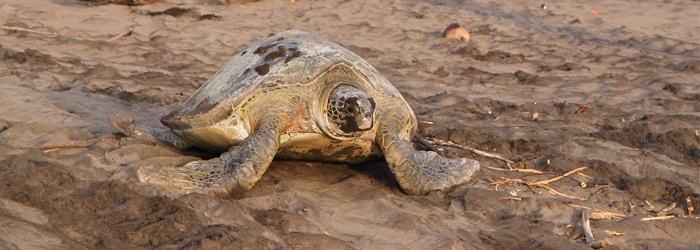Focus on conservation: Sea Turtle Conservancy
The world’s sea turtles have existed for over 100 million years, but their numbers are rapidly declining, largely due to human activity. Almost all species are classified as endangered, and threats include poaching, ocean pollution and debris, coastal development, accidental capture in fishing gear, and climate change.
One organization working to change that is the nonprofit Sea Turtle Conservancy (STC). Founded in 1959, the STC takes a multi-faceted approach that includes research, education, training, advocacy, and habitat protection to help protect the world’s sea turtles. Like Holbrook Travel, the STC is based in Gainesville, Fla., and the organizations’ histories have been intertwined for more than 25 years.
“They’re an excellent example of an organization that has incorporated a travel program to support their conservation goals, both in terms of fundraising and in terms of volunteer assistance,” says Holbrook Education & Eco Expedition Specialist Lisa Palmese-Graubard.
Voluntourism in action
In Tortuguero, Costa Rica, researchers and volunteers at the STC’s John H. Phipps Biological Field Station monitor nesting trends, growth rates and reproductive success as part of a long-term protection program. According to the STC, Tortuguero hosts the largest green turtle rookery in the Western Hemisphere and also important nesting populations of leatherback and hawksbill turtles.
Working with the STC, Holbrook has successfully facilitated one- and two-week eco-volunteer opportunities for as many as 50 individuals a year interested in contributing to these efforts. Volunteers get hands-on experience as they assist with track counts, measuring turtles, egg counts, nest marking, and recording data including tag numbers and nest locations. The field station, with the support of these volunteers, has seen a 500 percent increase in the green turtle nesting population since the 1970s.
Connecting conservation and travel
Additionally, the STC has recently organized several group travel programs for its members and other interested travelers to Cuba, including one scheduled for July 1-8, 2017. The benefits of these programs are twofold: participants assist Cuban researchers and biologists with data collection, and donations built into the trip cost assist with fundraising.
During the upcoming trip to Cuba, participants will meet local researchers and park rangers at Guanahacabibes Peninsula, which is home to the second largest breeding population of green turtles in the country, with an average of more than 300 nests per season. Participants will look for turtles coming ashore and observe the nesting process as the researchers collect data.
They’ll also be working with Dr. Julia Azanza Ricardo from the Guanahacabibes Marine Turtle Conservation Program. Dr. Azanza is a university professor and field scientist with 17 years of experience in sea turtle science and conservation in Cuba and is one of two national scientific coordinators of the marine turtle-monitoring program in Cuba’s National System of Protected Areas.
“A program like this that combines hands-on activities with local experts, educational components, and chances to explore some of Cuba’s prominent sites like Havana and Viñales Valley is attractive to members and donors, boosting participation and ultimately helping the STC achieve their conservation goals,” Lisa says.


